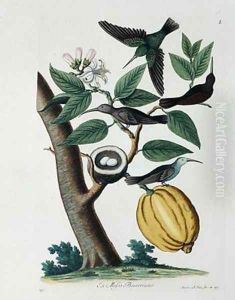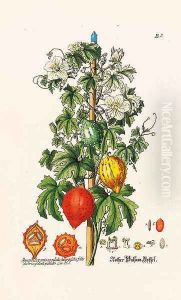G.W. Knorr Paintings
Georg Wolfgang Knorr was a German artist, engraver, and natural history illustrator born in Nuremberg in 1705. He is best known for his detailed and accurate engravings of animals, shells, fossils, and other natural history subjects. Knorr's work was a significant contribution to the scientific and artistic communities during the Enlightenment period, when there was a burgeoning interest in categorizing and understanding the natural world.
Knorr's artistic talent was evident early on, and he was apprenticed to a local artist to learn the craft of engraving. His skill and interest in the natural sciences soon led him to combine these two passions, resulting in a career where his engravings served as both works of art and scientific documentation. Knorr's engravings were used in several important scientific publications of the time.
Throughout his career, Knorr collaborated with other scientists and artists, such as the botanist Christoph Jacob Trew, with whom he worked on the multi-volume work 'Hortus Nitidissimis.' His most renowned work is 'Deliciae Naturae Selectae,' a collection of engravings that showcased the diversity and intricacy of the natural world. The detail and precision of his work not only provided a visual record for scientific study but also captured the imagination of the public.
Knorr's dedication to his craft and his contributions to the field of natural history illustration were cut short by his premature death in 1761. Despite his relatively short life, his work left an enduring legacy in the worlds of both art and science, influencing future generations of natural history artists and illustrators. His engravings continue to be appreciated for their beauty and scientific value.

